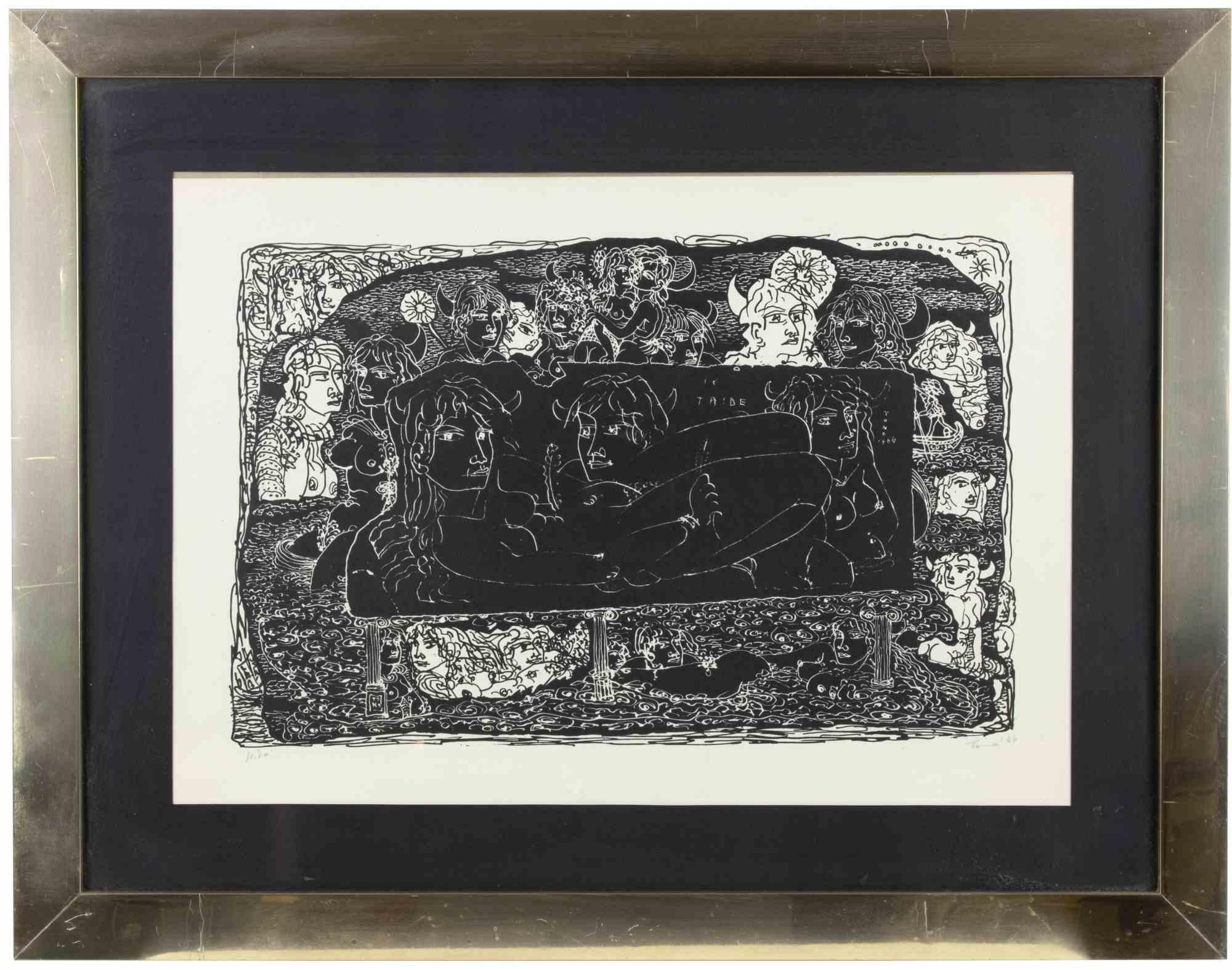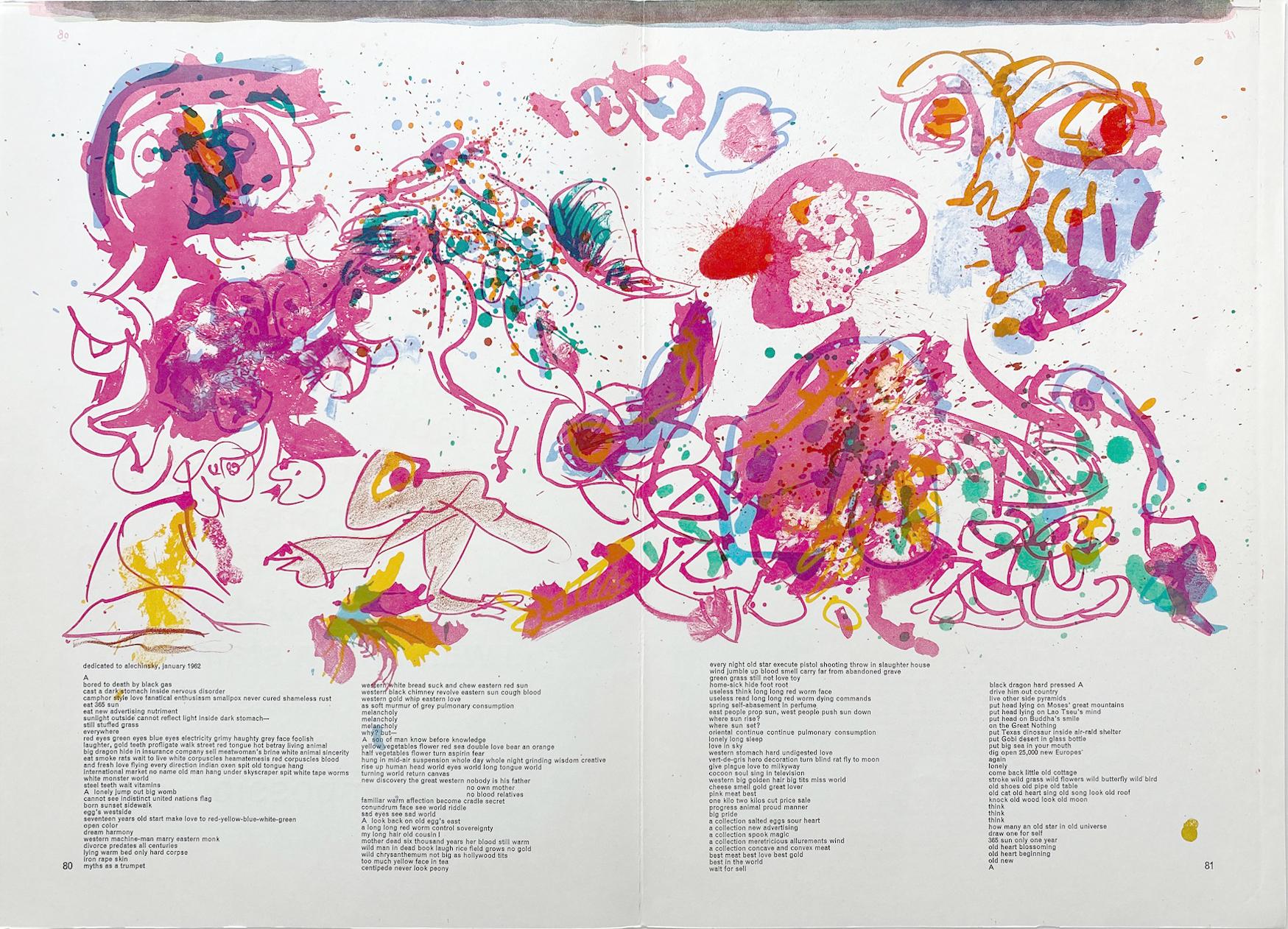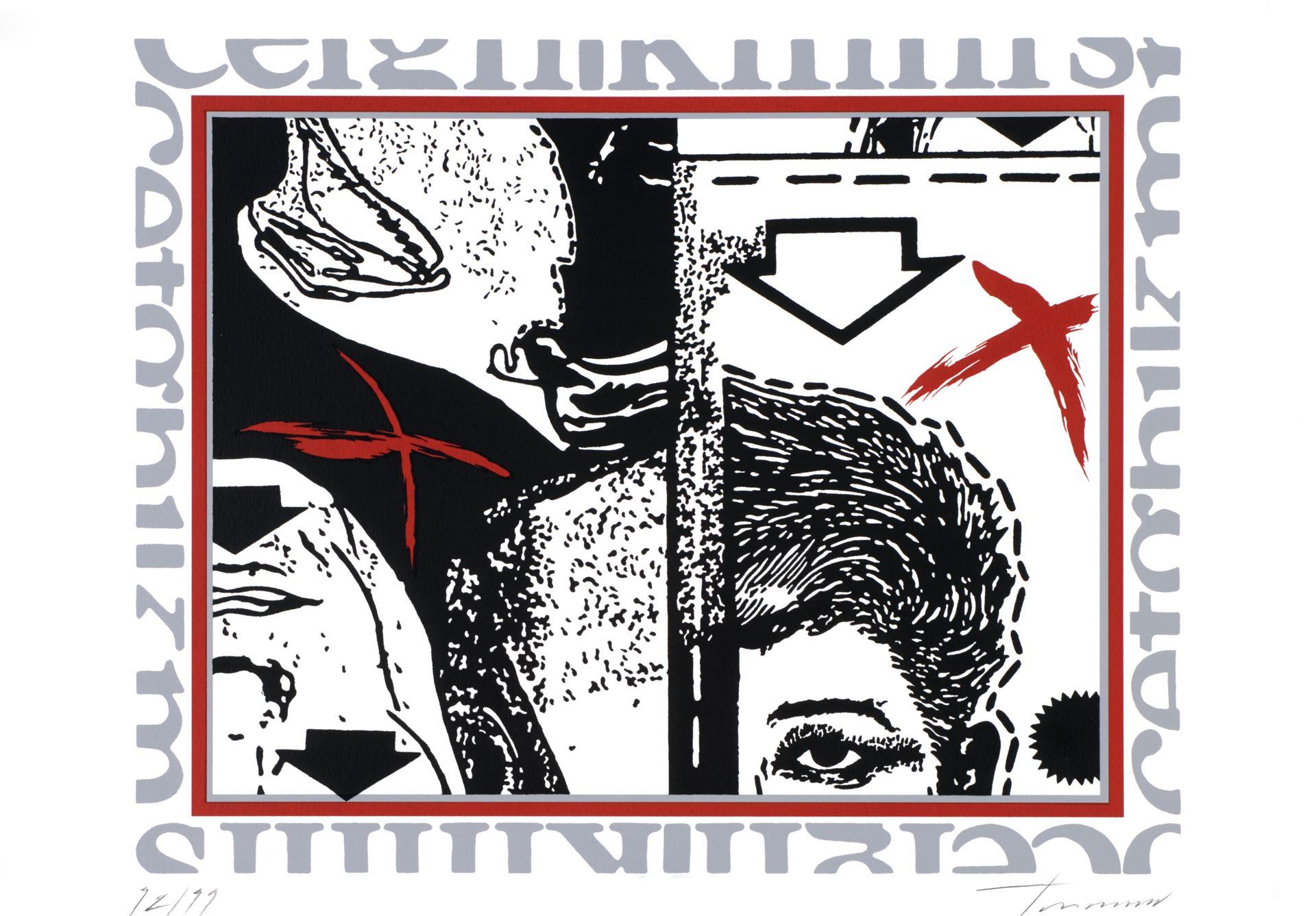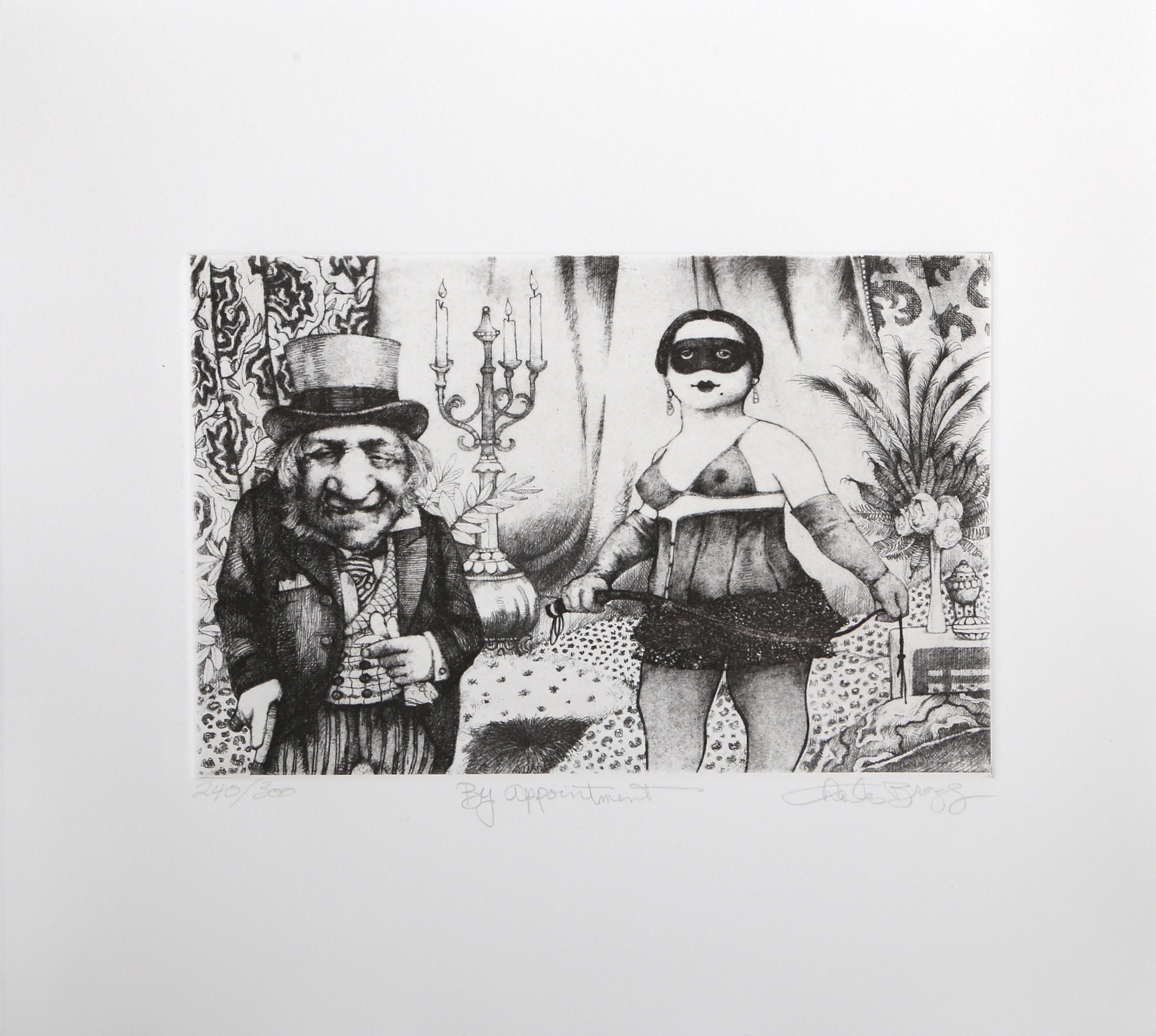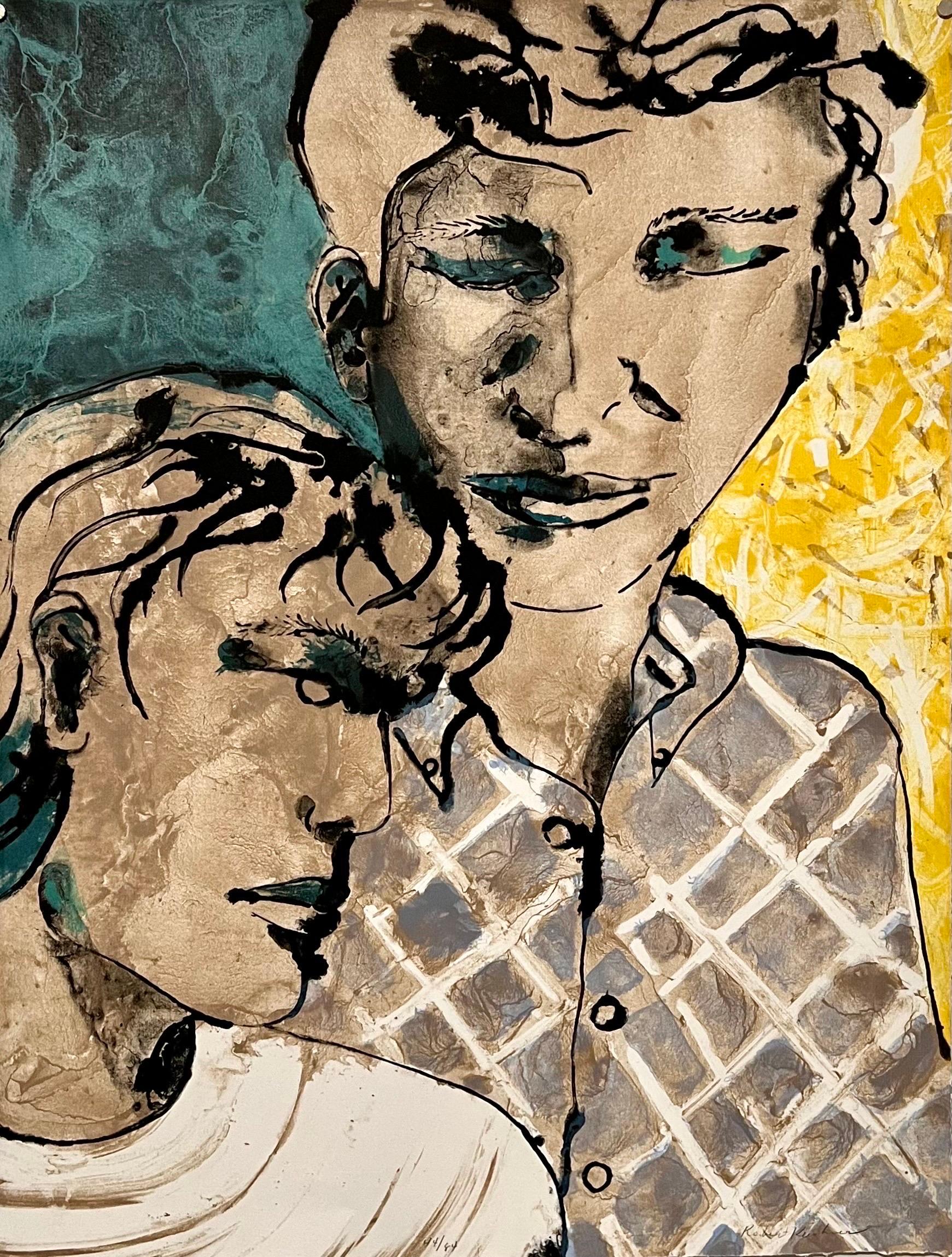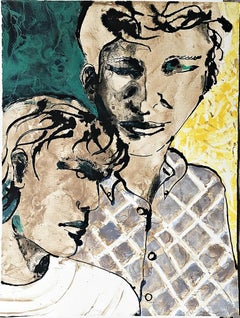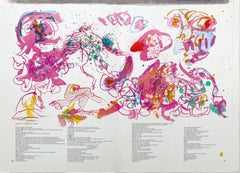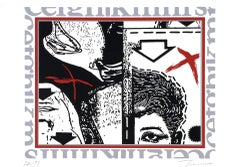Items Similar to Lithograph from from the Artsounds Collection, signed/n famed cult artist LGBTQ
Want more images or videos?
Request additional images or videos from the seller
1 of 6
Thomas Lanigan-SchmidtLithograph from from the Artsounds Collection, signed/n famed cult artist LGBTQ1986
1986
$1,500
£1,139.29
€1,316.25
CA$2,102.30
A$2,352.87
CHF 1,228.02
MX$28,692.93
NOK 15,716.98
SEK 14,878.13
DKK 9,823.02
Shipping
Retrieving quote...The 1stDibs Promise:
Authenticity Guarantee,
Money-Back Guarantee,
24-Hour Cancellation
About the Item
Thomas Lanigan-Schmidt
Untitled, from from the Artsounds Collection, 1986
Lithograph on paper
Signed and numbered from the edition of 200 in ink on the back; also bears artist's stamped name and provenance - Art Sounds portfolio.
12 × 12 inches
Unframed
Signed and numbered from the edition of 200 in ink on the back; also bears artist's stamped name and provenance - Art Sounds portfolio.
This terrific offset lithograph print exemplifies the combination of religion and kitsch that Lanigan Schmidt is best known for. This print was created in the 1980s for the famous Artsounds portfolio, which featured prints by Marcel Duchamp, Jonathan Borofsky among others. Lanigan-Schmidt was a subject of a 2013 retrospective at PS1 MOMA and is on the faculty of the School of Visual Arts in New York.
Provenance:
Artsounds Portfolio
About Thomas Lanigan-Schmidt:
Thomas Lanigan-Schmidt is represented in the collections of the Metropolitan Museum of Art, Whitney Museum of American Art, MoMA, Brooklyn Museum, Ludwig Forum für Internationale Kunst, Ackland Art Museum, Columbus Museum of Art, and Wadsworth Atheneum Museum of Art, among others. He has exhibited extensively throughout the United States and Europe, including the 1980 and 1984 Venice Biennales, the 1991 Whitney Biennial, and the 1999 exhibition The American Century: Art and Culture, 1950-2000, Whitney Museum of American Art, New York, NY. Recent solo exhibitions include Tenemental: With Sighs Too Deep for Words, Howl! Happening, New York (2018); Thomas Lanigan-Schmidt: Mysterium Tremendum, Rockland Art Center, NY (2013); and Ecce Homo: Thomas Lanigan-Schmidt & The Art of Rebellion, Pavel Zoubok Gallery, NY (2013).
Lanigan-Schmidt has been an instructor in the MFA program of the School of Visual Arts in New York City since the mid 80s and has served on the governing board of the Skowhegan School of Painting & Sculpture in Maine since 1992. In 2011, he was the recipient of the Louis Comfort Tiffany Foundation Biennial grant and in 2017 received awards from the American Academy of Arts and Letters, and the National Academy of Design. In June 2009, Lanigan-Schmidt was honored at the White House by President Barack Obama for his courageous participation in the 1969 Stonewall rebellion, and in 2016 he was the keynote speaker when the Stonewall Inn became a national monument. Lanigan-Schmidt was the subject of the critically acclaimed 2012 retrospective Tender Love Among the Junk at MoMA PS1, curated by Peter Eleey.
- Courtesy of Pavel Zoubok Fine Art
- Creator:Thomas Lanigan-Schmidt (1948, American)
- Creation Year:1986
- Dimensions:Height: 12 in (30.48 cm)Width: 12 in (30.48 cm)
- Medium:
- Movement & Style:
- Period:
- Condition:
- Gallery Location:New York, NY
- Reference Number:1stDibs: LU1745213368702
About the Seller
5.0
Platinum Seller
Premium sellers with a 4.7+ rating and 24-hour response times
Established in 2007
1stDibs seller since 2022
441 sales on 1stDibs
Typical response time: 2 hours
- ShippingRetrieving quote...Shipping from: New York, NY
- Return Policy
Authenticity Guarantee
In the unlikely event there’s an issue with an item’s authenticity, contact us within 1 year for a full refund. DetailsMoney-Back Guarantee
If your item is not as described, is damaged in transit, or does not arrive, contact us within 7 days for a full refund. Details24-Hour Cancellation
You have a 24-hour grace period in which to reconsider your purchase, with no questions asked.Vetted Professional Sellers
Our world-class sellers must adhere to strict standards for service and quality, maintaining the integrity of our listings.Price-Match Guarantee
If you find that a seller listed the same item for a lower price elsewhere, we’ll match it.Trusted Global Delivery
Our best-in-class carrier network provides specialized shipping options worldwide, including custom delivery.More From This Seller
View AllHonor Thy Father and Thy Mother (The Fifth Commandment) Lithograph Signed/N
By Robert Kushner
Located in New York, NY
Robert Kushner
Honor Thy Father and Thy Mother (The Fifth Commandment), 1987
6 Color Lithograph on Dieu Donne handmade paper
24 × 18 inches
Pencil signed and numbered 6/84 in graphite on the front
Unframed with deckled edges
This five color lithograph on Dieu Donne hand made paper with deckled edges is pencil signed, dated and numbered from the limited edition of 84. This 1980s Robert Kushner print was created as part of the 1987 portfolio "The Ten Commandments", in which ten top Jewish American artists were each invited to choose an Old Testament commandment to interpret in contemporary lithographic form. The "Chosen" artists were, in order of Commandment: Kenny Scharf, Joseph Nechvatal, Gretchen Bender, April Gornik, Robert Kushner, Nancy Spero, Vito Acconci, Jane Dickson, Judy Rifka and Richard Bosman. This is the first time the print will have been removed from the original portfolio case. (shown). Lisa Liebmann, who wrote the introduction to the collection, observed: "...The image has, for most of us, replaced the word..." With respect to the present work, she writes, "There is a sweet smell of nostalgia to Robert Kushner's view of the FIFTH COMMANDMENT, to honor one's parents. Kushner's subtly ornate use of colors suffuses his subject with a filagreed texture of warmth. In this gentle icon, the traditional duo - all those Ozzies and Harriets in our hearts and on the airwaves -are frames as if by a bubble bath of affection."
ROBERT KUSHNER BIOGRAPHY
Since participating in the early years of the Pattern and Decoration Movement in the 1970s, Robert Kushner has continued to address controversial issues involving decoration. Kushner draws from a unique range of influences, including Islamic and European textiles, Henri Matisse, Georgia O’Keeffe, Charles Demuth, Pierre Bonnard, Tawaraya Sotatsu, Ito Jakuchu, Qi Baishi, and Wu...
Category
1980s Contemporary Figurative Prints
Materials
Lithograph
Untitled, expressionistic woodcut print, from the Art Against AIDS Portfolio
By James Bettison
Located in New York, NY
James Bettison
Untitled, from the Art Against AIDS Portfolio, 1988
Woodcut on paper with deckled edges. Hand signed. Numbered 38/50. Dated. Printer's and Publisher's Blind Stamp.
20...
Category
1980s Contemporary Abstract Prints
Materials
Woodcut, Pencil
Leaving Home (97-301), 5 color lithograph on Rives BFK paper, Signed/N Tamarind
By DeLoss McGraw
Located in New York, NY
DeLoss McGraw
Leaving Home (97-301), 1997
Five color lithograph on tan Rives BFK paper with deckled edges
Signed and numbered 3/75 in graphite pencil on the front
17 × 24 3/25 inches...
Category
1990s Outsider Art Abstract Prints
Materials
Lithograph
Untitled Signed lithograph on Arches paper by world famous dog artist, unique TP
By Roy De Forest
Located in New York, NY
ROY DE FOREST
Untitled, 1981
Lithograph on Arches paper with four deckled edges.
22 1/2 × 30 inches
Hand signed and annotated Trial Proof, aside from the regular edition of 60
Unfra...
Category
1980s Contemporary Animal Prints
Materials
Archival Paper, Pencil, Graphite, Lithograph
Note D, silkscreen by renowned Russian-American Jewish dissident artist Signed/N
By Grisha Bruskin
Located in New York, NY
Grisha Bruskin
Note D, 1991
Color silkscreen on Somerset paper
34 × 27 inches
Edition 74/75
Boldly signed and numbered on front in graphite pencil.
Published by Marlborough Graphics ...
Category
1980s Modern Abstract Prints
Materials
Screen
California Cool Pop Art Mixed media & lithograph hand signed 20/20, artist label
By Billy Al Bengston
Located in New York, NY
Billy Al Bengston
Cockatoo AAA Dracula, 1968
Lithograph , Zinc and Aluminum, in Silver-Violet, Yellow, Two Grays and Orange on uncalendered Rives paper
Frame included
signed faintly ...
Category
1960s Pop Art Abstract Prints
Materials
Mixed Media, Lithograph
You May Also Like
Untitled - Lithograph by Tono Zancanaro - 1966
By Tono Zancanaro
Located in Roma, IT
Untitled is a modern artwork realized by Tono Zancanaro in 1966.
Black and white lithograph.
Hand signed and dated on the lower margin.
Artist's proof (as reported on the lower ma...
Category
1960s Contemporary Figurative Prints
Materials
Lithograph
"Untitled": Lithograph from One Cent Life
By Pierre Alechinsky
Located in Austin, TX
Artist: Pierre Alechinsky
Title: "Untitled": Lithograph from One Cent Life
Year: 1964
Medium: 2 page lithograph, as printed from One Cent Life
As printed with Walasse Ting poem, fro...
Category
1960s Expressionist Portrait Prints
Materials
Lithograph
$225 Sale Price
50% Off
Argentinean Artist hand signed limited edition original art print silkscreen n6
Located in Miami, FL
Luis Rodolfo Trimano (Argentina, 1943)
' Untitled VI from Estigmas', 2006
silkscreen on paper
19.7 x 27.6 in. (50 x 70 cm.)
Edition of 99
Unframed
ID: TRI1706-001-106_6
Hand-signed b...
Category
Early 2000s Contemporary Prints and Multiples
Materials
Paper, Engraving, Screen
by Appointment, Folk Art Etching by Charles Bragg
By Charles Bragg
Located in Long Island City, NY
Charles Bragg, American (1931 - 2017) - By Appointment, Year: circa 1970, Medium: Etching, signed, numbered, and titled in pencil, Edition: 300, Image Size: 7 x 10 inches, Size: 14...
Category
1970s Folk Art Figurative Prints
Materials
Etching
Lithograph Print Pattern & Decoration Art Honor Father & Mother Robert Kushner
By Robert Kushner
Located in Surfside, FL
Robert Ellis Kushner (American, b.1949).
44/84 Lithograph on paper titled " Honor thy Mother and Father"; Depicting a husband and wife (I have seen this print described as a screenprint and as a lithograph)
Hand signed in pencil and dated alongside an embossed pictorial blindstamp of a closed hand with one raised index finger. Solo Press.
From The Ten Commandments Kenny Scharf; Joseph Nechvatal; Gretchen Bender; April Gornik; Robert Kushner; Nancy Spero; Vito Acconci; Jane Dickson; Judy Rifka; Richard Bosman and Lisa Liebmann.
Robert Kushner, born in 1949, in California, lives in New York, and is a painter and sculptor. He gained attention in the early seventies as a performance artist, using food, fabric and nudity. Kushner was associated with the Pattern and Decoration movement and used fabric collage in large-scale, bold paintings of the figure. Since 1987 he has used flowers as the subject of his paintings, more recently adding a cornucopia of fruits and vegetables to his repertoire. Kushner's use of rich color harmonies and bold, fluid drawing, mark his belief in the importance of beauty in our lives. Kushner draws from a unique range of influences, including Islamic and European textiles, Henri Matisse, Georgia O'Keeffe, Charles Demuth, Pierre Bonnard, Tawaraya Sotatsu, Ito Jakuchu, Qi Baishi, and Wu Changshuo. Kushner’s work combines organic representational elements with abstracted geometric forms in a way that is both decorative and modernist. Kushner has collaborated with Master printer Bud Shark since 1982 on various monotypes and lithographs. These exuberant, sensuous prints often include collage elements, including glitter, chine-collé, metal leaf and hand coloring.
Kushner's work has been exhibited extensively in the United States, Europe, and Japan and has been included in the Whitney Biennial three times and twice at the Venice Biennale in Italy. He was the subject of solo exhibitions at both the Whitney Museum of American Art and the Brooklyn Museum. A mid-career retrospective of his work was organized by the Philadelphia Institute of Contemporary Art. He was one of the original painters of the Pattern and Decoration movements of the 1970s. (along with Cynthia Carlson, Brad Davis, Mary Grigoriadis, Joyce Kozloff, Robert Kushner, Kim MacConnel, Sonya Rapoport, Miriam Schapiro and Valerie Jaudon) The group began exhibiting together in 1976 in "Ten Approaches to the Decorative" at the Alessandra Gallery in New York, followed by "Pattern Painting" in 1977 at PS1 in Long Island City, Queens. Subsequently, over fifty group exhibitions featuring the founding artists were held in museums and galleries in Europe and the U.S. including the National Gallery of Art in Washington, D.C., the Art Institute of Chicago, Palais des Beaux Arts, Brussels, Louisiana Museum of Modern Art in Humlebaek, Denmark, the Neue Galerie, in Aachen, Germany, the Pori Art Museum, the Mayor Gallery in London, Modern Art Oxford, and the Hudson River Museum in Yonkers, New York.Robert Kushner's prints include a lithograph with gold leaf titled White Lilac and a series of monotypes that include Blue Bells II, Geranium IV, and Oregon Grape III. Robert Kushner lives in New York and has completed several major public commissions. He has exhibited his work widely and is represented in the collections of The Brooklyn Museum, Los Angeles County Museum, The Metropolitan Museum, NY, The San Francisco Museum of Modern Art, The Tate Gallery, London, The Whitney Museum, NY and others.
In 1997 Hudson Hills Press published the monograph, Robert Kushner: Gardens of Earthly Delight by Alexandra Anderson-Spivey. The New Jersey Center for Visual Arts mounted the survey exhibition Robert Kushner: 25 Years of Making Art in 1998.
Kushner's work is represented in numerous important public collections:
Albright-Knox Art Gallery, Buffalo, NY
Art Collection of the United States Embassy, Panama
Australian National Gallery, Canberra, Australia
The Baltimore Museum of Art, Baltimore, MD
Bowdoin College Museum of Art, Brunswick, ME
The Brooklyn Museum of Art, Brooklyn, NY
California Palace of the Legion of Honor, San Francisco, CA
Carnegie Museum of Art, Pittsburgh, PA
The Columbus Museum of Art, Columbus, OH
The Contemporary Museum, Honolulu, HI
The Corcoran Gallery of Art, Washington, DC
Galleria degli Ufizzi, Florence, Italy
Gröninger Museum, Gröningen, the Netherlands
Honolulu Academy of Arts, Honolulu, Hawaii
J. Paul Getty Trust, Los Angeles, CA
Library of Congress, Washington, D.C.
Los Angeles County Museum of Art, Los Angeles, CA
The Metropolitan Museum of Art, New York, NY
Museum Ludwig, Cologne, Germany
Museum Ludwig, St. Petersburg, Russia
Museum Moderner Kunst - Palais Lichtenstein, Vienna, Austria
The Museum of Modern Art, New York, NY
The National Gallery of Art, Washington, D.C.
Neue-Galerie-Sammlung Ludwig, Aachen, Germany
Philadelphia Museum of Art, Philadelphia, PA
Rockefeller Center, New York, NY
San Francisco Museum of Modern Art, San Francisco, CA
The Tate Gallery, London, England
Whitney Museum of American Art, New York, NY
Select Exhibitions:
Robert Kushner: 30 Literary Nudes, Luis De Jesus, Santa Monica, CA
Robert Kushner: The Language of Flowers, DC Moore...
Category
1980s Contemporary Figurative Prints
Materials
Lithograph, Screen
Untitled, from The Song of Songs of King Solomon (hand signed lithograph)
By Théo Tobiasse
Located in Aventura, FL
Lithograph in colors on Japon paper. Hand signed and numbered by Theo Tobiasse. Edition HC LVI (there is also a main edition of 200). Artwork size 22 x 30 inches.
Artwork is i...
Category
Late 20th Century Contemporary Portrait Prints
Materials
Lithograph
More Ways To Browse
Cult Of Vintage
American Fur Awards
1984 Tiffany
Vintage Kitsch Art
Junk Art Sculpture
Retro Sound Speaker
Tiffany Speaker
Picasso Gold Plate
Picasso Pots
Stained Glass Cartoon
The Vintage Tarot
Vietnam War Poster
Woodblock Moon
Yvette Guilbert Lithograph
1930s Elsa Schiaparelli
Anna Weatherly
Cartoons For Stained Glass
Chagall Esther
